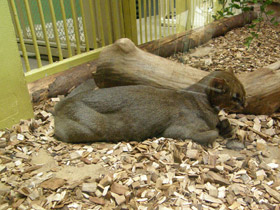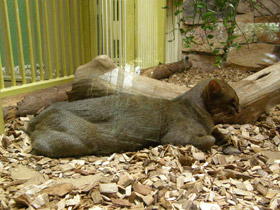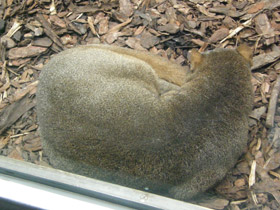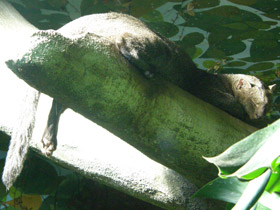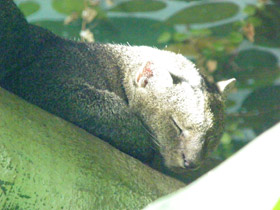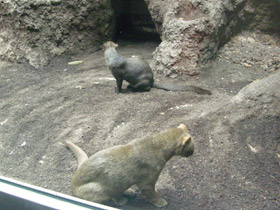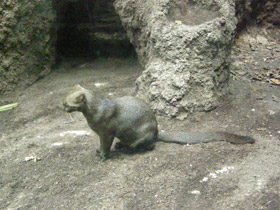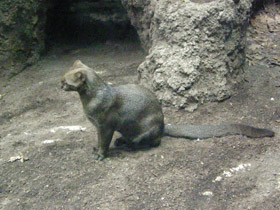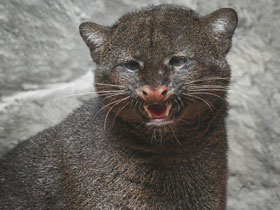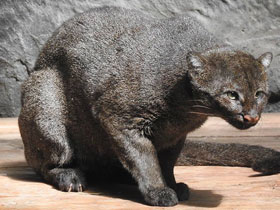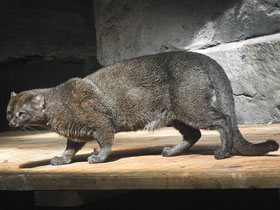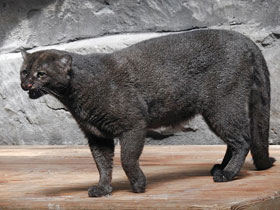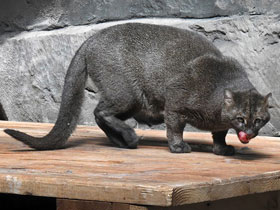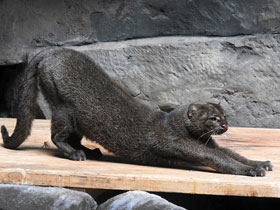The jaguarundi (Herpailurus yagouaroundi)
Jaguarundi видео
The jaguarundi (Herpailurus yagouaroundi; /ˌdʒæɡwəˈrʌndi/ or /ˌʒæɡwəˈrʌndi/) is a wild cat native to the Americas.
Appearance
Herpailurus yagouaroundi is a species belonging to the family Felidae.
It is an unusual cat that does not look like a cat. Its outward appearance is more like that of an animal of the cat or wyvern family: it has an elongated, flexible body, with short, strong legs and a long, thin tail. This structure seems to help this cat navigate through thick bushes or forest canopies.
It measures 55-77 cm in length and 33-60 cm at the tail, 25-35 cm at the withers and weighs 4.5-9 kg. The head is small and rounded, the ears small and rounded and the muzzle short. Previously, this species was classified in a separate genus, Herpailurus, but zoologists have now included it in the genus Puma. The jaguarundi also has a colouring that is unusual for felines: monochromatic, brown or bright red. Newborn jaguars are sometimes finely mottled, but adults have no body markings.
Habitat and lifestyle
These unusual felines are widespread from the southern United States to northern Argentina, along the coast of Mexico, in Peru, Paraguay and southern Brazil. They are found in a variety of habitats: savannahs, thorny chaparral and tropical rainforests. The jaguarundi tends to settle near water: in wetlands, along the banks of streams, rivers and lakes. In the mountains, they climb up to 3200 m above sea level. These furtive animals are mostly solitary but, unlike most cats, they are mostly active during the day. Although the jaguarundi is an arboreal animal, it can climb and swim well, although it tends to climb trees only when absolutely necessary, usually at low altitudes.
Nutrition
The jaguarundi feeds on a variety of small mammals, reptiles, birds, frogs, fish and insects. Of mammals, this cat prefers Florida rabbits, reed hamsters, guinea pigs and chinchillas. It can chase its prey for a kilometre or more. In small numbers, the jaguarundi also eats plant foods (fruits) and insects. In Panama, they ravage plantations by climbing trees and eating the green fruits of figs.
Reproduction
Little is known about the reproduction of the jaguarundi. Recent observations have revealed that these animals, long thought to be solitary, sometimes occupy a plot in pairs or even groups. Typically, the plots of males overlap with those of several females.
During mating, the jaguarundi fights vigorously and emits loud cries. Females burrow in empty fallen trees or dense thickets. After a gestation period of 70-75 days, 2-4 blind and helpless kittens are born. The kittens in a litter may be of different colours.
About 21 days after birth, the female begins to bring the kittens pet food, and on the 28th day they come out of the den for the first time. The mother feeds the pups with milk for about a month. At 40-42 days of age, the cubs hunt alone, but are not separated from their mother until they are 2 years old.
Due to its wide range, this animal is not a protected species, although it has become rare in the southern United States. Apparently, before the arrival of Europeans, Latin American Indians domesticated the jaguarundi to protect houses from small rodents and other pests. Indeed, young jaguars are easily domesticated and become accustomed to humans. The skin of the jaguarundi has no value and is not hunted, but sometimes jaguars are caught in traps set for other animals. However, the main negative impact on their population is the destruction of their natural habitat and the depletion of food resources.
Taxonomy
In 1803 Étienne Geoffroy Saint-Hilaire described two jaguarundi skins and skulls from unknown locations in Central America and proposed the scientific name Felis yagouarundi. In the 19th and 20th centuries, several more zoological specimens were described:
- Felis eyra proposed by Gotthelf Fischer von Waldheim in 1814 was a ferruginous skin from Paraguay.
- Felis cacomitli proposed by Jean-Louis Berlandier in 1859 was a skull and a grayish skin of a female jaguarundi from the Rio Grande area in Mexico.
- Felis yagouaroundi tolteca proposed by Oldfield Thomas in 1898 was a skull and a reddish skin from Sinaloa in Mexico.
- Felis Ameghinoi proposed by Eduardo Ladislao Holmberg in 1898 for fossil cat bones, presumably of a jaguarundi, that were excavated near San Luis, Argentina.
- Felis fossata by Edgar Alexander Mearns in 1901 was a large jaguarundi skull from Yucatán.
- Felis panamensis by Joel Asaph Allen in 1904 was a dusky gray skin of a young adult female jaguarundi collected in Panama's Chiriquí Province.
- Felis yagouaroundi melantho by Oldfield Thomas in 1914 were skulls and blackish brown skins of a male and a female from Pozuzo District in Peru.
The generic name Herpailurus was proposed by Nikolai Severtzov in 1858 for the jaguarundi. Later authors classified the jaguarundi in the genus Puma along with the cougar (P. concolor). Phylogeographical analysis of jaguarundi samples from across its range found no genetic evidence for subspecies. In 2017, the IUCN Cat Specialist Group revised felid taxonomy and recognises the jaguarundi as a monotypic taxon of the genus Herpailurus.
Threats and conservation
The jaguarundi has been listed as Least Concern on the IUCN Red List since 2002. Mexican populations, except those in the northeast, appear to be stable. The huge protected areas in the Amazon Basin are probably the only conservation units that can sustain long-term viable populations. IUCN Red List assessors noted that it should be listed as Near Threatened, but the data were not sufficient to extend this classification throughout the jaguarundi's range. The jaguarundi is not particularly sought after for its fur due to its poor quality and low value, but it is suffering decline due to habitat loss.
Other threats include risks of habitat fragmentation and persecution for killing poultry. The North and Central American jaguarundi populations are listed in CITES Appendix I and all the other populations are listed in CITES Appendix II. Populations in the US are protected under the Endangered Species Act; the Texas Parks and Wildlife Department has expressed concern that its presence in South Texas may be imperiled due to loss of the cat's native habitat. Populations in Mexico are listed under the Mexican Official Norm NOM-059-SEMARNAT-2010.
Hunting jaguarundi is restricted in Peru and banned in Argentina, Belize, Brazil, Bolivia, Colombia, Costa Rica, French Guiana, Guatemala, Honduras, Mexico, Panama, Paraguay, Suriname, Uruguay, United States, and Venezuela.

















